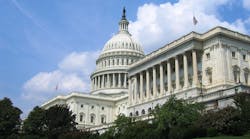Even as those attending the 2017 Technology & Maintenance Council (TMC) annual meeting kicked the tires and examined the electronics of today’s ever-evolving commercial trucks, a big political gathering occurred back in the nation’s capital – one that is going to impact the trucking industry in a variety of ways.
Some 300 folks from 44 states are attending the annual Washington Briefing” organized by the American Association of State Highway and Transportation Officials (AASHTO) at the Washington Court Hotel in the shadow the U.S. Capitol Building and they heard from the politicians who are going to shape infrastructure and transportation policy for next several years.
Many are longtime veterans of the political battlefields in the halls of Congress: House Transportation and Infrastructure (T&I) Committee Chairman Bill Shuster (R-PA) and House T&I Committee Ranking Member Rep. Peter DeFazio (D-Ore.), are just two of them.
They shared their thoughts on one of the more pressing issues facing President Trump’s infrastructure plans: how to fund it.
“How are we going to get that revenue? It’s going to come from a lot of different sources,” noted Shuster, such as the repatriation of taxes, user fees, cutting federal spending in other areas of the federal government so it can be shifted to fund infrastructure.
Peter DeFazio noted that there is a “struggle” going on in the White House and Congress about the funding question. He believes there is a lot more “rank and file appetite” for spending on infrastructure and ways to get it – getting $60 billion in funding through a small tax on goods coming through U.S. harbors is one example he’s proposed.
Sen. John Barrasso (R-WY.), chairman of the U.S. Senate’s Environment and Public Works (EPW) committee noted that though there is “significant bickering” in Congress, in both the House of Representatives and the Senate, most agree on the need for infrastructure funding.
“All of us have needs, all of us have interests, and all of us have concerns: that is why I am always optimistic about what we can do for our infrastructure and for our highways,” he explained.
So; can the political logjams of the last eight years be broken in order to bring a big comprehensive infrastructure plan to the table? A plan that would significantly upgrade our nation’s economic competitiveness and improve freight throughput as well?
We’ll have to wait and see for the political process to make it happen is only just now beginning.



